SHOWCASE PRODUCTS
Last updated: 18 July 1998
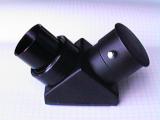 Shutan Camera & Video sent me their Wide-Field Adapter (WFA) for review. I have only worked with it a few minutes on a couple of days and one night but I wanted to get this report online since there seems to be a lot of interest in this accessory. I will add to this report as soon the weather and time cooperate.
Shutan Camera & Video sent me their Wide-Field Adapter (WFA) for review. I have only worked with it a few minutes on a couple of days and one night but I wanted to get this report online since there seems to be a lot of interest in this accessory. I will add to this report as soon the weather and time cooperate.
The WFA is similar to a 90 degree diagonal or erecting prism (see photo on the right). It also acts as a focal reducer to effectively shorten the focal length of the ETX. It comes with a 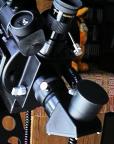 nice plastic cover for the eyepiece hole (thanks Shutan!). The setscrew (the silver object in this photo) secures the eyepiece in place. The WFA attaches to the Shutan Visual Back
nice plastic cover for the eyepiece hole (thanks Shutan!). The setscrew (the silver object in this photo) secures the eyepiece in place. The WFA attaches to the Shutan Visual Back 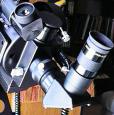 at the rear of the ETX (see photo on the left). Then your 26mm eyepiece (or any eyepiece) is inserted in the WFA (see photo on the right). You will now see wider view of the sky through the eyepiece, with a corresponding reduction in magnification.
at the rear of the ETX (see photo on the left). Then your 26mm eyepiece (or any eyepiece) is inserted in the WFA (see photo on the right). You will now see wider view of the sky through the eyepiece, with a corresponding reduction in magnification.
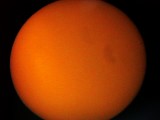 The picture of the sun on the left (taken with my Casio digital camera) shows the view through the 26mm eyepiece mounted at the normal eyepiece position on top of the ETX.
The picture of the sun on the left (taken with my Casio digital camera) shows the view through the 26mm eyepiece mounted at the normal eyepiece position on top of the ETX. 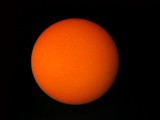 The one on the right shows the view using the WFA and 26mm eyepiece. This will give you an idea of the difference when viewing the sky. Shutan says that the increase is approximately 64%. I have not yet confirmed this figure although it seems the magnification with the WFA is reduced to about 65% of what it is without it.
The one on the right shows the view using the WFA and 26mm eyepiece. This will give you an idea of the difference when viewing the sky. Shutan says that the increase is approximately 64%. I have not yet confirmed this figure although it seems the magnification with the WFA is reduced to about 65% of what it is without it.
I have spent only a few minutes using it to view the night sky. Star images were distinct points of light with no distortion. There was only slight vignetting (a darkening at the edge of the field-of-view) when used with the 26mm eyepiece. But this did not appear to be a problem as it is hardly noticeable. I have not yet tried higher power eyepieces. If your intention is to get a wider view of regions of the sky you will probably only use a low-power eyepiece with the WFA. If you want to see a larger portion of the moon at higher magnifications you will want to use a higher power eyepiece with the WFA. I'll report on using higher power eyepieces in an update to this report.
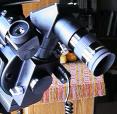 The documentation supplied with the WFA says that it has to be mounted on the Visual Back. This is true if you want to mount it at the rear of the ETX. The documentation also says it can be used with other telescopes. So I decided to see if it would work when mounted in the eyepiece hole on the top of the ETX (see photo on the right). I can report that this does in fact work, at least with the 26mm eyepiece. There was more noticeable vignetting but still not too much. I'll report on using higher power eyepieces in this position in an update to this report.
The documentation supplied with the WFA says that it has to be mounted on the Visual Back. This is true if you want to mount it at the rear of the ETX. The documentation also says it can be used with other telescopes. So I decided to see if it would work when mounted in the eyepiece hole on the top of the ETX (see photo on the right). I can report that this does in fact work, at least with the 26mm eyepiece. There was more noticeable vignetting but still not too much. I'll report on using higher power eyepieces in this position in an update to this report.
The WFA is nicely made and showed no flaws physically or optically. If you want a wider view of the sky from your ETX, there are two options: a wide-angle eyepiece or a wide-field adapter. Given that wide-angle eyepieces are expensive, the Shutan Wide-Field Adapter is certainly a less-costly but very effective solution. Even if you add the cost of the $30 Visual Back, the price is still less than most wide-angle eyepieces. I'm looking forward to seeing the rich star fields in the Milky Way using the Shutan Wide-Field Adapter.
[4/30] I had a brief opportunity to try the Meade 9.7mm eyepiece with the WFA. It worked well and image quality remained very high. The view of the crescent moon with both the 26mm and 9.7mm through the WFA was very crisp. As noted previously, more area of the moon was visible with the 9.7mm and WFA combination than with just using the 9.7mm alone. You can see comparison images of the crescent moon in the Astrophotography - Moon. Of course, these handheld digital camera images don't do justice to the actual image quality. One thing I did notice during this session is that when swapping eyepieces from the normal eyepiece hole on top of the ETX to the WFA there is a significant change in focus. I had to run the JMI MotoFocus for several seconds to refocus. This is not a problem (except to reduce battery life!); just something to be aware of.
[5/25] I have now purchased this accessory. Its utility for me provided a reason to purchase it. I look forward to seeing wide-angle views of the Milky Way when it becomes sufficiently visible.
[6/21] I mounted the Meade Basic Camera Adapter to the Wide-Field Adapter and tried some photos of the moon with my Pentax SLR. With the 26mm eyepiece, the image was small but crisp and bright. Just what you would expect. I then tried the same with the 9.7mm eyepiece but I could not achieve a focus on the camera's viewscreen. With the WFA mounted in the eyepiece holder instead of at the rear port I was still unable to achieve a focus. As this is an abnormal mounting combination I do not see the problem as serious, just something to note.
[7/18] I finally got a chance to view the Milky Way star fields in Sagitarius with the Wide-Field Adapter and the 26mm eyepiece. NICE! Stars were crisp points of light with some hints of nebulosity in places (there were some interferring lights). I also used the Right Angle Finder Conversion to approximately locate the Ring Nebula (M57) in Lyra. I then looked through the Wide-Field Adapter and the 26mm eyepiece and there was M57 in the field-of-view. Definitely a good demonstration of the value of a wide angle view. I then centered M57 in the 26mm, flipped the ETX mirror to the normal eyepiece position where I had the 9.7mm eyepiece, refocused, and there was M57. Other than the need to refocus, this technique is useful to view faint objects at higher magnifications.
Visual Back
Mini-Tele Extender
5956316
5956254
$30
$30
 Shutan Camera & Video sent me three of their ETX accessories for review. I finally had a one night break in the El Nino rainstorms here in Southern California to try them out. The Right Angle Finder Conversion is to address the main problem with the Meade ETX finderscope: that of not being very usable when the ETX is pointed near the Zenith. As shipped, the Conversion is a tube with a small mirror mounted at one end. There is no lens in the tube; you use the objective lens, the objective lens locking ring, and eyepiece from your existing ETX finderscope. The instructions on disassembling and assembling the finderscope are clear. You remove the finderscope from the ETX and then remove its lens, ring, and eyepiece. You then screw these onto the conversion tube in the proper locations. For some reason the locking ring would not thread onto the conversion tube although the objective lens went on fine. Both the lens and ring thread onto the Meade finderscope OK so the problem is with the conversion tube's threads. I asked Shutan about this problem and they have seen it occur in a very small percentage of conversion kits. Shutan sent me another Kit from a different production run and it experienced the same problem. The finder can be sent to Shutan and they will ensure a proper fit and return it. Shutan has updated the installation instructions to mention this free (except for shipping to them) service. Fortunately, this occurrence does seem rare, otherwise they would stop selling the product since it would not be worth the hassle. Not attaching the locking ring seemed to cause no problem in my case as the objective lens stayed in position and retained its focus during ETX use. In actual use, the 90 degree finderscope performs very well. The image is sharp with no ghosts (so the mirror is of a reasonably high quality). But is a straight-through or 90 degree finder really better? When sighting the ETX at angles well away from the Zenith, I have found that a straight-through finder may be more convenient whereas at the Zenith a right angle finder is definitely a must with the ETX. Consider the following scenario: you point the ETX in the approximate direction of the object you want to observe. You may do this by sighting along the ETX OTA (optical tube assembly). Then you move your head to the Finderscope for a more accurate positioning. If the finderscope is straight through, it is a simple matter to look through the finder whereas if using a right angle finder you have to change your whole body position to look down through the finder's eyepiece. Each user will have to decide which is better. Another consideration is where in the sky the objects are that you want to view. If near the Zenith, there is no question that a right angle finder is almost a necessity and the Shutan one is an inexpensive solution. I almost wish that I could have both style finders on my ETX. In fact, I could: the Shutan finderscope could be mounted normally and then I could use the Rigel Systems QuikFinder for straight-through sighting. Best of both worlds. Comments from other users on the Shutan Right Angle Finder Conversion are available on the Accessories - Finderscopes page.
Shutan Camera & Video sent me three of their ETX accessories for review. I finally had a one night break in the El Nino rainstorms here in Southern California to try them out. The Right Angle Finder Conversion is to address the main problem with the Meade ETX finderscope: that of not being very usable when the ETX is pointed near the Zenith. As shipped, the Conversion is a tube with a small mirror mounted at one end. There is no lens in the tube; you use the objective lens, the objective lens locking ring, and eyepiece from your existing ETX finderscope. The instructions on disassembling and assembling the finderscope are clear. You remove the finderscope from the ETX and then remove its lens, ring, and eyepiece. You then screw these onto the conversion tube in the proper locations. For some reason the locking ring would not thread onto the conversion tube although the objective lens went on fine. Both the lens and ring thread onto the Meade finderscope OK so the problem is with the conversion tube's threads. I asked Shutan about this problem and they have seen it occur in a very small percentage of conversion kits. Shutan sent me another Kit from a different production run and it experienced the same problem. The finder can be sent to Shutan and they will ensure a proper fit and return it. Shutan has updated the installation instructions to mention this free (except for shipping to them) service. Fortunately, this occurrence does seem rare, otherwise they would stop selling the product since it would not be worth the hassle. Not attaching the locking ring seemed to cause no problem in my case as the objective lens stayed in position and retained its focus during ETX use. In actual use, the 90 degree finderscope performs very well. The image is sharp with no ghosts (so the mirror is of a reasonably high quality). But is a straight-through or 90 degree finder really better? When sighting the ETX at angles well away from the Zenith, I have found that a straight-through finder may be more convenient whereas at the Zenith a right angle finder is definitely a must with the ETX. Consider the following scenario: you point the ETX in the approximate direction of the object you want to observe. You may do this by sighting along the ETX OTA (optical tube assembly). Then you move your head to the Finderscope for a more accurate positioning. If the finderscope is straight through, it is a simple matter to look through the finder whereas if using a right angle finder you have to change your whole body position to look down through the finder's eyepiece. Each user will have to decide which is better. Another consideration is where in the sky the objects are that you want to view. If near the Zenith, there is no question that a right angle finder is almost a necessity and the Shutan one is an inexpensive solution. I almost wish that I could have both style finders on my ETX. In fact, I could: the Shutan finderscope could be mounted normally and then I could use the Rigel Systems QuikFinder for straight-through sighting. Best of both worlds. Comments from other users on the Shutan Right Angle Finder Conversion are available on the Accessories - Finderscopes page.
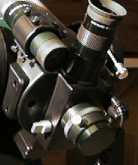 The Visual Back is a simple accessory which allows eyepieces to be used at the rear port of the ETX. It threads onto the ETX and the ETX rear port cover can be threaded on the Visual Back to close off the port when no eyepiece is inserted. Being able to cover the port with the Back attached is very handy. In use you insert an eyepiece, tighten the setscrew to hold the eyepiece in position, flip the ETX mirror, and then focus. In this position, you eliminate one
The Visual Back is a simple accessory which allows eyepieces to be used at the rear port of the ETX. It threads onto the ETX and the ETX rear port cover can be threaded on the Visual Back to close off the port when no eyepiece is inserted. Being able to cover the port with the Back attached is very handy. In use you insert an eyepiece, tighten the setscrew to hold the eyepiece in position, flip the ETX mirror, and then focus. In this position, you eliminate one 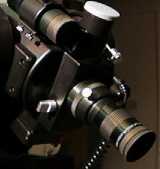 mirror bounce (if such things worry you). One benefit of having an eyepiece in this position is when observing sitting down, although viewing near the Zenith will be difficult if not impossible with an eyepiece here. I found it quite handy to leave the Back attached with an eyepiece inserted and another eyepiece inserted at the normal ETX top eyepiece port. This way I could just flip the mirror and refocus to change magnification. I was able to use my 26mm, 9.7mm, and 2X Barlow Lens with the Visual Back. In this usage, the Shutan Visual Back is a lower cost alternative to the $53 Meade 45-Degree Erecting Prism which also mounts at the rear of the ETX. I rarely leave the Meade Erecting Prism attached due to its large size but I expect to leave the Shutan Visual Back attached at all times as it is small while adding convenience.
mirror bounce (if such things worry you). One benefit of having an eyepiece in this position is when observing sitting down, although viewing near the Zenith will be difficult if not impossible with an eyepiece here. I found it quite handy to leave the Back attached with an eyepiece inserted and another eyepiece inserted at the normal ETX top eyepiece port. This way I could just flip the mirror and refocus to change magnification. I was able to use my 26mm, 9.7mm, and 2X Barlow Lens with the Visual Back. In this usage, the Shutan Visual Back is a lower cost alternative to the $53 Meade 45-Degree Erecting Prism which also mounts at the rear of the ETX. I rarely leave the Meade Erecting Prism attached due to its large size but I expect to leave the Shutan Visual Back attached at all times as it is small while adding convenience.
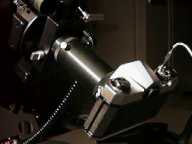 The Mini-Tele Extender attaches to the Visual Back (which is required) and allows eyepiece projection at the rear of the ETX. You attach the Visual Back to the ETX rear port, insert an eyepiece into the Extender, thread the Extender onto the Visual Back, tighten the setscrew, and then attach your camera body (a T-Mounting Ring is required). Now you are ready for eyepiece projection astrophotography. This is similar to using the $33 Meade Basic Camera Adapter at the normal eyepiece port on top of the ETX. As I note on the ETX Gallery page, the extra weight of the camera will likely cause tracking errors for any exposures longer than a few seconds. I will be taking some photographs using the Shutan Mini-Tele Extender and will post the results when available.
The Mini-Tele Extender attaches to the Visual Back (which is required) and allows eyepiece projection at the rear of the ETX. You attach the Visual Back to the ETX rear port, insert an eyepiece into the Extender, thread the Extender onto the Visual Back, tighten the setscrew, and then attach your camera body (a T-Mounting Ring is required). Now you are ready for eyepiece projection astrophotography. This is similar to using the $33 Meade Basic Camera Adapter at the normal eyepiece port on top of the ETX. As I note on the ETX Gallery page, the extra weight of the camera will likely cause tracking errors for any exposures longer than a few seconds. I will be taking some photographs using the Shutan Mini-Tele Extender and will post the results when available.
I will add more comments on these accessories as I use them (assuming El Nino cooperates and lets me have some clear nights).
[3/31] Finally, the skies cleared (for one night, anyway) and I spent some more time with these accessories. I'm still debating whether a right-angle finder is more useful than Meade's straight-through one. I spent all of this session observing the crescent moon low on the western horizon so I found having a right-angle finder really didn't come into play. But there is no question that the Visual Back is more useful. As I noted previously, having one eyepiece in the normal position and another one in the Visual Back is really very convenient. In fact, I can find no drawback to using this accessory (unless you already own the Meade alternative mentioned above). I took some photos of the moon using the Visual Back and the Casio digital camera and through the combination of the Visual Back and Mini-Tele Extender using the Pentax Spotmatic (see the Astrophotography - Moon page for the Casio shots). For some objects, this combination will be fine and but its cost ($60, considering you need both accessories), is greater than the $33 Meade Basic Camera Adapter if all you are interested in is eyepiece projection astrophotography. But if you don't need the erecting capability of the $53 Meade 45-Degree Erecting Prism, then the combination is more cost-effective since you get two accessories for nearly the same price.
[5/25] I have now purchased these accessories from Shutan. I have found them to be a useful addition to my ETX.
[6/21] I have posted a photo of the moon using the combination of the Visual Back and Mini-Tele Extender with the Pentax Spotmatic.